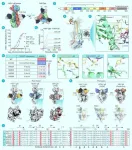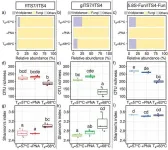(Press-News.org) Sight loss in certain inherited eye diseases may be caused by gut bacteria, and is potentially treatable by antimicrobials, finds a new study in mice co-led by a UCL and Moorfields researcher.
The international study observed that in eyes with sight loss caused by a particular genetic mutation, known to cause eye diseases that lead to blindness, gut bacteria were found within the damaged areas of the eye.
The authors of the new paper, published in Cell and jointly led by researchers in China, say their findings suggest that the genetic mutation may relax the body’s defences, thus allowing harmful bacteria to reach the eye and cause blindness.
The gut contains trillions of bacteria, many of which are key to healthy digestion. However, they can also be potentially harmful.
The researchers were investigating the impact of the Crumbs homolog 1 (CBR1) gene, which is known to be expressed in the retina (the thin layer of cells at the back of the eye) and is crucial to building the blood-retina barrier to regulate what flows in and out of the eye.
The CRB1 gene is associated with inherited eye disease, most commonly forms of Leber congenital amaurosis (LCA) and retinitis pigmentosa (RP); the gene is the cause of 10% of LCA cases and 7% of RP cases worldwide.
Using mouse models, the research team discovered the CRB1 gene is key to controlling the integrity of the lower gastrointestinal tract, the first ever such observation. There, it combats pathogens and harmful bacteria by regulating what passes between the contents of the gut and the rest of the body.
The team found that when the gene has a particular mutation, dampening its expression (reducing its effect), these barriers in both the retina and the gut can be breached, enabling bacteria in the gut to move through the body and into the eye, leading to lesions in the retina that cause sight loss.
Crucially, treating these bacteria with antimicrobials, such as antibiotics, was able to prevent sight loss in the mice even though it did not rebuild the affected cell barriers in the eye.
Inherited eye diseases are the UK’s leading cause of blindness in working-age people. Onset of disease may vary from very early childhood to adulthood, but deterioration is irreversible and has lifelong implications. To date, the development of treatments has largely focused on gene therapies.
The findings of this study suggest that simply using antimicrobials might help prevent deterioration in CRB1-associated inherited eye diseases. Future work will investigate whether this applies in humans.
Co-lead author Professor Richard Lee (UCL Institute of Ophthalmology and Moorfields Eye Hospital NHS Foundation Trust) said: “We found an unexpected link between the gut and the eye, which might be the cause of blindness in some patients.
“Our findings could have huge implications for transforming treatment for CRB1-associated eye diseases. We hope to continue this research in clinical studies to confirm if this mechanism is indeed the cause of blindness in people, and whether treatments targeting bacteria could prevent blindness.
“Additionally, as we have revealed an entirely novel mechanism linking retinal degeneration to the gut, our findings may have implications for a broader spectrum of eye conditions, which we hope to continue to explore with further studies.”
The study was an international collaboration led by researchers from Zhongshan Ophthalmic Center, Sun Yat-sen University, China, working with UCL Institute of Ophthalmology and Moorfields Eye Hospital NHS Foundation Trust.
END
Blindness from some inherited eye diseases may be caused by gut bacteria
2024-02-26
ELSE PRESS RELEASES FROM THIS DATE:
Journal of Pharmaceutical Analysis articles provide novel insights into previously unknown disease mechanisms
2024-02-26
DCM is the leading cause of heart failure in patients with chronic diabetes. However, the underlying mechanisms of DCM are poorly understood, and treatment options are limited. Another mystery is the regulation of cytochrome P450 enzymes (CYPs) in the central nervous system. Moreover, the link between the gut microbiome, microbiota-derived metabolites, and the progression of AD remains unknown. In the December issue of JPA, three articles provide insights into the pathologies of DCM, hippocampal neurotoxicity, and AD, providing a comprehensive ...
Enhancing electrogenerated chemiluminescence of an iridium complex
2024-02-26
Electrogenerated chemiluminescence (ECL) cells, characterized by their self-emissive nature, have gathered significant interest for prospective display applications due to their uncomplicated structure and straightforward fabrication process. These cells are created by sandwiching a solution-based emitting layer between two transparent electrodes. Nevertheless, when compared to other self-emissive devices like light-emitting diodes (LED) and organic LEDs, the luminescent performance of ECL cells ...
The structure of HSV-1 gB bound to a potent neutralizing antibody reveals a conservative antigenic domain across herpesviruses
2024-02-26
Human herpesviruses comprise the alpha, beta, and gamma subfamilies and are a widely prevalent group of DNA-enveloped viruses, capable of establishing lifelong latent infections in humans and causing various diseases. Among them, herpes simplex virus (HSV) belongs to the alpha herpesvirus group and infects a wide population, causing symptoms like oral or genital herpes. As an enveloped virus, HSV possesses a series of glycoproteins involved in virus recognition, adhesion, and infection processes. Among these, gB serves as the viral fusion protein, mediating the fusion between the virus and host cell membranes, and ...
Fighting the flu: The surprising power of a century-old vaccine for tuberculosis
2024-02-26
As Canada’s flu season collides with record strep A cases and ongoing COVID-19 concerns, a new study is shedding light on our understanding of respiratory immune responses. Scholars from the Research Institute of the McGill University Health Centre (RI-MUHC) have discovered a surprising facet about a century-old vaccine for tuberculosis, Bacillus Calmette Guérin (BCG). The study, published in the journal Nature Immunology, uncovered a previously unknown mechanism that extends the vaccine’s shield to combat influenza A virus—the most prevalent flu strain.
“The immune interactions ...
The effects of primer pairs, PCR conditions, and peptide nucleic acid clamps on plant root fungal diversity assessment
2024-02-26
Fungi are frequently found both around and within plant tissues (especially in roots) and are involved in both plant nutrient acquisition and resistance to pathogens. Thus, characterizing the diversity and composition of plant-associated fungal communities has been a growing interest in recent years.
High-throughput sequencing (HTS), also called metabarcoding, has become a prominent tool to assess complex microbial communities from environmental samples. However, HTS applied to plant-associated ...
Can hunger be eradicated by 2030?
2024-02-26
World hunger is growing at an alarming rate, with prolonged conflicts, climate change, and COVID-19 exacerbating the problem. In 2022, the World Food Programme helped a record 158 million people. On this trajectory, the United Nations’ goal to eradicate hunger by 2030 appears increasingly unattainable. New research at McGill University shines the spotlight on a significant piece of the puzzle: international food assistance.
With no global treaty in place, food aid is guided by a patchwork of international agreements and institutions. Using the concept of a “regime ...
A novel method for easy and quick fabrication of biomimetic robots with life-like movement
2024-02-26
Ultraviolet-laser processing is a promising technique for developing intricate microstructures, enabling complex alignment of muscle cells, required for building life-like biohybrid actuators, as shown by Tokyo Tech researchers. Compared to traditional complex methods, this innovative technique enables easy and quick fabrication of microstructures with intricate patterns for achieving different muscle cell arrangements, paving the way for biohybrid actuators capable of complex, flexible movements.
Biomimetic robots, which mimic the movements and biological functions of living organisms, are a fascinating area of research that ...
Austria isolates and genotypes Leptospira bacteria for the first time
2024-02-26
[Vienna, Feb 26 2024] — Leptospirosis is a globally distributed infectious disease that affects both animals and humans. While the infection is endemic in tropical regions, its incidence seems to increase in temperate regions. The serological diagnostic test used in routine to detect antibodies against the bacteria responsible for the disease performs better when local variants are used. In Austria, however, no locally circulating strain has been available to date. A new study, published in the latest issue of Scientific Reports, has now been able to close this research gap.
"In our study, ...
Major new funding supports early career investigators working on cures for pancreatic cancer
2024-02-26
Bethesda, MD (Feb. 26, 2024) — The AGA Research Foundation has announced a $1.4 million endowment grant from The Bern Schwartz Family Foundation. The AGA Institute will provide matching support, resulting in a $2.8 million endowment dedicated to advancing basic research in pancreatic cancer, the third leading cause of cancer deaths in the U.S.
The endowment will fund a second AGA-Bern Schwartz Family Fund Research Scholar Award in Pancreatic Cancer. The first award, created in 2013, will also continue. Both awards provide selected early career-investigators with $100,000 per year for three years ...
Poison center calls for ‘magic mushrooms’ spiked after decriminalization, study finds
2024-02-26
Calls to U.S. poison centers involving psilocybin, or “magic mushrooms,” among adolescents and young adults rose sharply after several U.S. cities and states began decriminalizing the hallucinogen, University of Virginia School of Medicine researchers have found.
Psilocybin-related calls more than tripled among teens ages 13-19 from 152 to 464 and more than doubled among adults ages 20-25 from 125 to 294 between 2018 and 2022, according to anonymized data gathered from the National Poison Data System. Local and state efforts to decriminalize the possession, use and cultivation of psilocybin began in May 2019. Oregon and Colorado have decriminalized psilocybin, as ...






